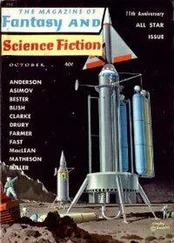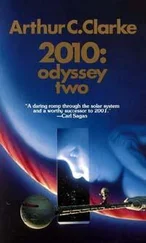Out of the Sun
by Arthur C. Clarke
If you have only lived on Earth, you have never seen the sun. Of course, we could not look at it directly, but only through dense filters that cut its rays down to endurable brilliance. It hung there forever above the low, jagged hills to the west of the Observatory, neither rising nor setting, yet moving around a small circle in the sky during the eighty-eight-day year of our little world. For it is not quite true to say that Mercury keeps the same face always turned toward the sun; it wobbles slightly on its axis, and there is a narrow twilight belt which knows such terrestrial commonplaces as dawn and sunset.
We were on the edge of the twilight zone, so that we could take advantage of the cool shadows yet could keep the sun under continuous surveillance as it hovered there above the hills. It was a full-time job for fifty astronomers and other assorted scientists; when we’ve kept it up for a hundred years or so, we may know something about the small star that brought life to Earth.
There wasn’t a single band of solar radiation that someone at the Observatory had not made a life’s study and was watching like a hawk. From the far X-rays to the longest of radio waves, we had set our traps and snares; as soon as the sun thought of something new, we were ready for it. So we imagined…
The sun’s flaming heart beats in a slow, eleven-year rhythm, and we were near the peak of the cycle. Two of the greatest spots ever recorded—each of them large enough to swallow a hundred Earths—had drifted across the disk like great black funnels piercing deeply into the turbulent outer layers of the sun. They were black, of course, only by contrast with the brilliance all around them; even their dark, cool cores were hotter and brighter than an electric arc. We had just watched the second of them disappear around the edge of the disk, wondering if it would survive to reappear two weeks later, when something blew up on the equator.
It was not too spectacular at first, partly because it was almost exactly beneath us—at the precise center of the sun’s disk—and so was merged into all the activity around it. If it had been near the edge of the sun, and thus projected against the background of space, it would have been truly awe-inspiring.
Imagine the simultaneous explosion of a million H-bombs. You can’t? Nor can anyone else—but that was the sort of thing we were watching climb up toward us at hundreds of miles a second, straight out of the sun’s spinning equator. At first it formed a narrow jet, but it was quickly frayed around the edges by the magnetic and gravitational forces that were fighting against it. The central core kept right on, and it was soon obvious that it had escaped from the sun completely and was headed out into space—with us as its first target.
Though this had happened half a dozen times before, it was always exciting. It meant that we could capture some of the very substance of the sun as it went hurtling past in a great cloud of electrified gas. There was no danger; by the tune it reached us it would be far too tenuous to do any damage, and, indeed, it would take sensitive instruments to detect it at all.
One of those instruments was the Observatory’s radar, which was in continual use to map the invisible ionized layers that surround the sun for millions of miles. This was my department; as soon as there was any hope of picking up the oncoming cloud against the solar background, I aimed my giant radio mirror toward it.
It came in sharp and clear on the long-range screen—a vast, luminous island still moving outward from the sun at hundreds of miles a second. At this distance it was impossible to see its finer details, for my radar waves were taking minutes to make the round trip and to bring me back the information they were presenting on the screen. Even at its speed of not far short of a million miles an hour, it would be almost two days before the escaping prominence reached the orbit of Mercury and swept past us toward the outer planets. But neither Venus nor Earth would record its passing, for they were nowhere near its line of flight.
The hours drifted by; the sun had settled down after the immense convulsions that had shot so many millions of tons of its substance into space, never to return. The aftermath of that eruption was now a slowly twisting and turning cloud a hundred times the size of Earth, and soon it would be close enough for the short-range radar to reveal its finer structure.
Despite all the years I have been in the business, it still gives me a thrill to watch that line of light paint its picture on the screen as its spins in synchronism with the narrow beam of radio waves from the transmitter. I sometimes think of myself as a blind man exploring the space around him with a stick that may be a hundred million miles in length. For man is truly blind to the things I study; these great clouds of ionized gas moving far out from the sun are completely invisible to the eye and even to the most sensitive of photographic plates. They are ghosts that briefly haunt the solar system during the few hours of their existence; if they did not reflect our radar waves or disturb our magnetometers, we should never know that they were there.
The picture on the screen looked not unlike a photograph of a spiral nebula, for as the cloud slowly rotated it trailed ragged arms of gas for ten thousand miles around it. Or it might have been a terrestrial hurricane that I was watching from above as it spun through the atmosphere of Earth. The internal structure was extremely complicated and was changing minute by minute beneath the action of forces which we have never fully understood. Rivers of fire were flowing in curious paths under what could only be the influence of electric fields; but why were they appearing from nowhere and disappearing again as if matter was being created and destroyed? And what were those gleaming nodules, larger than the moon, that were being swept along like boulders before a flood?
Now it was less than a million miles away; it would be upon us in little more than an hour. The automatic cameras were recording every complete sweep of the radar scan, storing up evidence which was to keep us arguing for years. The magnetic disturbance riding ahead of the cloud had already reached us; indeed, there was hardly an instrument in the Observatory that was not reacting in some way to the onrushing apparition.
I switched to the short-range scanner, and the image of the cloud expanded so enormously that only its central portion was on the screen. At the same time I began to change frequency, turning across the spectrum to differentiate among~ the various levels. The shorter the wave length, the farther you can penetrate into a layer of ionized gas; by this technique I hope to get a kind of X-ray picture of the cloud’s interior.
It seemed to change before my eyes as I sliced down through the tenuous outer envelope with its trailing arms -and approached the denser core. “Denser,” of course, was a purely relative word; by terrestrial standards even its most closely packed regions were still a fairly good vacuum. I had almost reached the limit of my frequency band, and could shorten the wave length no farmer, when I noticed the curious, tight little echo not far from the center of the screen.
It was oval and much more sharp-edged than the knots of gas” we had watched adrift in the cloud’s fiery streams. Even in that first glimpse, I knew that here was something very strange and outside all previous records of solar phenomena. I watched it for a dozen scans of the radar beam, then called my assistant away from the radiospectrograph, with which he was analyzing the velocities of the swirling gas as it spun toward us.
“Look, Don,” I asked him, “have you ever seen anything like that?”
Читать дальше












